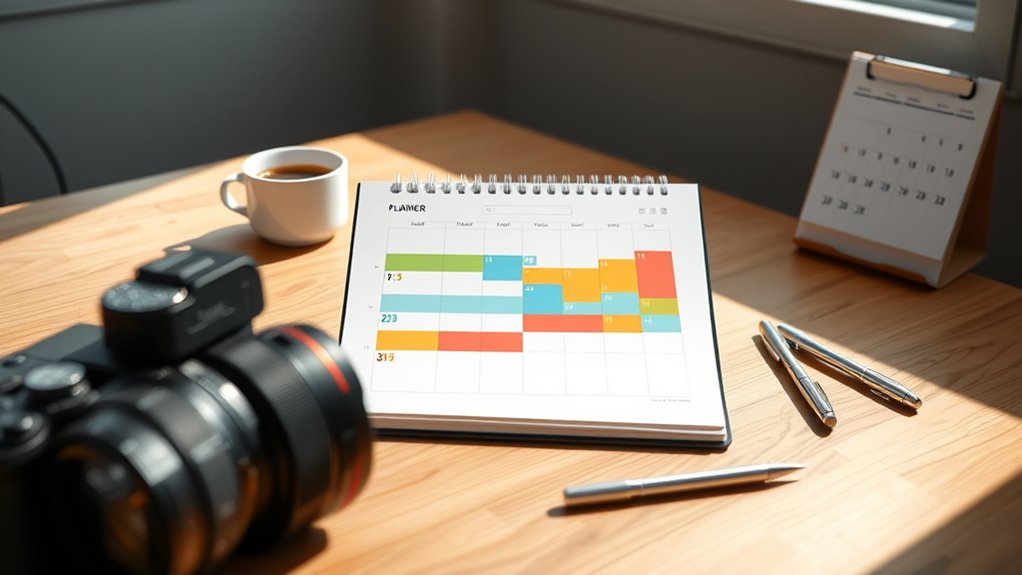Time blocking helps you organize your day by setting aside specific periods for tasks, boosting your focus and productivity. It encourages planning ahead, prioritizing high-impact activities, and avoiding multitasking. Using your calendar with color codes and clear labels makes your schedule visible and manageable. This technique reduces distractions, keeps you disciplined, and guarantees your energy is well distributed. If you’re curious about creating an effective time block schedule, there’s plenty more to explore to make it work for you.
Key Takeaways
- Time blocking involves scheduling specific periods for tasks to enhance focus and prevent time wastage.
- Prioritize high-impact tasks and allocate peak energy times for deep work within your schedule.
- Use your calendar to create a visual layout, incorporating color-coding and labels for clarity and organization.
- Identify key tasks, assign realistic time frames, and include breaks or buffers to accommodate unexpected delays.
- Consistent use of time blocking reduces distractions, boosts productivity, and promotes disciplined time management.

Time blocking is a powerful productivity technique that helps you manage your day more effectively by scheduling specific periods for different tasks. It encourages you to plan your day in advance, assigning dedicated time slots to the most important activities. This method relies heavily on task prioritization, making sure that your highest-priority tasks get the attention they deserve. When you use time blocking, you’re fundamentally creating a visual layout of your day, which makes it easier to focus on what truly matters and avoid wasting time on less critical activities. Proper calendar management becomes crucial here because your calendar isn’t just a list of appointments—it’s your blueprint for productivity. By blocking out chunks of time for each task, you prevent overlap and reduce the chances of procrastination creeping in.
To start, you need to identify your most important tasks for the day or week. Once you know what needs your attention, you can assign specific time frames to accomplish these tasks. For instance, you might allocate the first two hours of your morning to deep work, such as project development or strategic planning, when your energy levels are high. Following that, you might reserve a 30-minute window for checking emails and messages, instead of letting them interrupt your flow throughout the day. This approach ensures you’re not constantly switching gears, which can drain your focus and reduce productivity. When you plan your day in this way, you’re actively practicing task prioritization—placing your most valuable work at the top of your schedule. Additionally, understanding calendar management helps you optimize your schedule further by using tools and techniques to stay organized and disciplined.
Effective calendar management also involves being realistic about how long tasks take and leaving buffer times between blocks. This helps you adapt if unexpected issues arise or if certain tasks take longer than expected. Using color-coding or labels for different types of activities can make your calendar more intuitive and visually organized. For example, you could assign blue to meetings, green to deep work, and yellow to breaks. This visual system not only enhances clarity but also makes it easier to see at a glance whether you’re maintaining a balanced schedule. As you get used to this process, you’ll find it easier to stick to your planned blocks, reducing the tendency to multitask or get sidetracked.
Frequently Asked Questions
How Do I Adjust Time Blocks for Unexpected Tasks?
When unexpected tasks arise, you should quickly assess their urgency and importance using prioritization techniques. Adjust your time blocks by reallocating or shortening existing ones, and leave buffer periods for flexibility strategies. This approach helps you stay adaptable without sacrificing productivity. Remember, being flexible with your schedule guarantees you can handle surprises efficiently, keeping your workflow smooth while addressing unforeseen tasks promptly.
What Tools Are Best for Digital Time Blocking?
Think of digital calendars and productivity apps as your trusty compass in a busy sea. They’re the best tools for digital time blocking, guiding your day with precision. Apps like Google Calendar, Outlook, or Todoist let you carve out, adjust, and visualize your schedule effortlessly. With notifications and integrations, they keep you on course, ensuring unexpected waves don’t throw you off track. Embrace these tools, and your time becomes your most reliable vessel.
Can Time Blocking Improve Work-Life Balance?
Yes, time blocking can improve your work-life balance by helping you prioritize tasks and set boundaries. It acts as a productivity hack, enabling you to focus on work during designated times and enjoy personal moments without guilt. This structured approach reduces stress by preventing last-minute rushes, giving you better stress management. Ultimately, it creates a clear separation between work and personal life, leading to a healthier, more balanced routine.
How Long Should Each Time Block Typically Be?
You should typically aim for 25 to 90-minute time blocks, depending on your task and focus level. Shorter blocks boost productivity tips by keeping you engaged, while longer ones suit deep work. Use effective scheduling strategies by breaking tasks into manageable chunks, allowing flexibility. Experiment to find your ideal duration, balancing work and breaks, so you stay energized and productive without burnout.
How Do I Stay Consistent With My Time Blocks?
Did you know that it takes about 21 days to form a new habit? To stay consistent with your time blocks, focus on habit formation by setting clear intentions and tracking your progress. Use motivation strategies like rewarding yourself for sticking to your schedule and visualizing your goals. Keep your environment organized and remind yourself of the benefits, turning your time blocking into a natural, automatic part of your daily routine.
Conclusion
Now that you’ve learned how to harness the power of time blocking, imagine the freedom you’ll feel when your days are organized, your goals within reach, and stress diminishes. Like a finely tuned symphony, your schedule becomes a harmonious flow, turning chaos into clarity. Embrace this method, and watch your productivity soar—your best self waiting just beyond the horizon. The key is in your hands; now, take that first step and unfasten your true potential.









